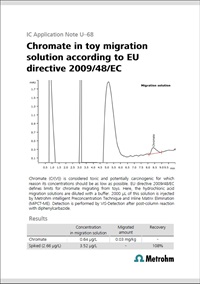Members Login

Channels
Special Offers & Promotions
Chromium (VI) in toys
Children are exposed to intakes of heavy metals from a wide variety of sources. Chromium (VI) in particular represents a potential hazard, as it is absorbed from food and drinking water, from the air that is breathed, from textiles, from utensils that contain metal and from toys.
 The analytical determination of chromium (VI) content in toys for compliance with limit values is described in the European standard DIN EN-71-3-2013 (Safety of toys Part 3 – Migration of certain elements).
The analytical determination of chromium (VI) content in toys for compliance with limit values is described in the European standard DIN EN-71-3-2013 (Safety of toys Part 3 – Migration of certain elements).
The standard differentiates between three categories, depending on the kind of toys:
Category I – migration limit: 0.02 mg/kg of Cr(VI)
- Dry, brittle, powder-like or soft toy materials e.g., leads of pencil crayons, chalk, wax crayons …
Category II – migration limit: 0.005 mg/kg of Cr(VI)
- Liquid or sticky toy materials, finger paints, liquid ink or soap solutions, …
Category III – migration limit: 0.2 mg/kg of Cr(VI)
- Scraped-off toy materials: coats of paint, printing inks, decorative paints, …
- Paper and cardboard, glass, ceramics, metallic materials, uncoloured and colored materials, e.g., wood and leather
Metrohm has developed an ion chromatography method for this application using preconcentration and Inline Matrix Elimination.
A portion of the migration solution produced in accordance with the regulation DIN EN 71-3:2013-07 is placed on a preconcentration column where a rinsing solution is used to elute the matrix from the column. In the second step, chromatographic separation takes place on an anion exchanger. Detection is accomplished using a very specific post-column derivatization in combination with UV/VIS detection.
Media Partners


